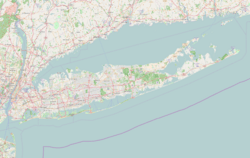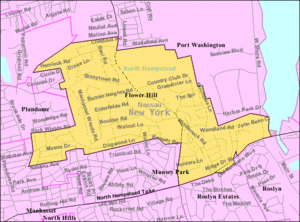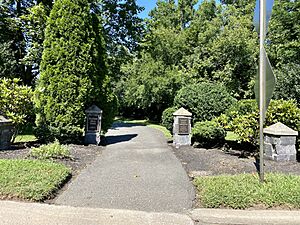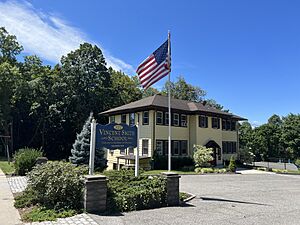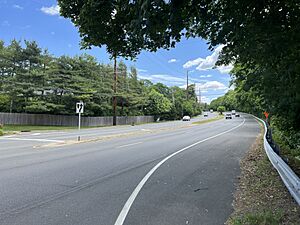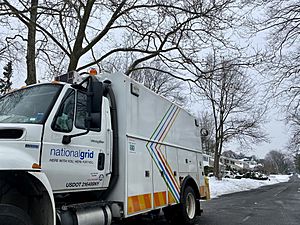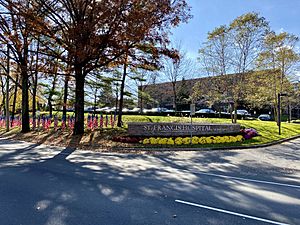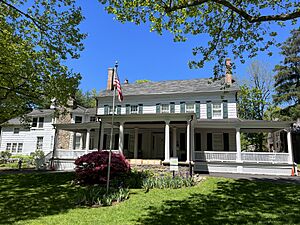Flower Hill, New York facts for kids
Quick facts for kids
Flower Hill, New York
|
||
|---|---|---|
| Incorporated Village of Flower Hill | ||
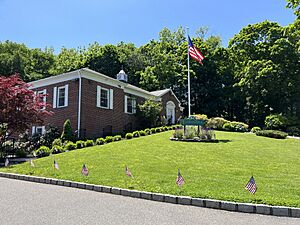
Flower Hill Village Hall in 2023, with flags on the lawn to celebrate Memorial Day.
|
||
|
||
| Nickname(s):
"FH"; "VFH"; "F. Hill"; "The Hill"
|
||
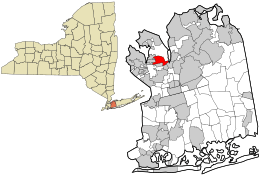
Location in Nassau County and the state of New York
|
||
| Country | ||
| State | ||
| County | Nassau | |
| Town | North Hempstead | |
| Incorporated | May 25, 1931 | |
| Founded by | Carlos W. Munson | |
| Area | ||
| • Total | 1.61 sq mi (4.18 km2) | |
| • Land | 1.61 sq mi (4.18 km2) | |
| • Water | 0.00 sq mi (0.00 km2) | |
| Elevation | 167 ft (51 m) | |
| Population
(2020)
|
||
| • Total | 4,794 | |
| • Density | 2,973.95/sq mi (1,148.26/km2) | |
| Demonym(s) | Flower Hiller Manhassetonian Port Washingtonian Roslynian Roslynite |
|
| Time zone | UTC-5 (Eastern (EST)) | |
| • Summer (DST) | UTC-4 (EDT) | |
| ZIP Codes |
11030, 11050, 11576
|
|
| Area codes | 516, 363 | |
| FIPS code | 36-26352 | |
| GNIS feature ID | 0950308 | |
Flower Hill is a small village in Nassau County, located on the North Shore of Long Island, in New York. It's a special place where different communities meet. The eastern part of the village is close to Roslyn, while the western and northern parts are near Manhasset and Port Washington.
In 2020, about 4,794 people lived in Flower Hill. The village is entirely within the Town of North Hempstead. Since 2013, Flower Hill has been recognized as a Tree City USA because of its efforts to care for trees.
Contents
History of Flower Hill
Before the Village: Early Days to 1930
The land where Flower Hill is today was first home to the Matinecock Native Americans. In the 1600s, settlers from Europe, mainly Dutch and English, began to move here.
Important families like the Hewletts settled in the area. They built the Hewlett Homestead around 1713. This area was perfect for farms. Farmers would send their goods to Manhasset Bay or Hempstead Harbor for shipping to New York City and other places.
The center of old Flower Hill was where Port Washington Boulevard, Bonnie Heights Road, and Country Club Drive meet today. It had a blacksmith, a general store, a tavern, a well, and a cemetery.
Around 1900, Carlos Munson, whose family owned the Munson Steamship Company, moved to Flower Hill. He later bought land and gave some to the Franciscan Missionaries of Mary.
In the early 1900s, a trolley system, the New York and North Shore Traction Company, ran through the village. It connected places like Mineola, Roslyn, and Port Washington. The trolleys used roads like Northern Boulevard and Port Washington Boulevard.
Becoming a Village: 1930 to 1931
The idea to make Flower Hill an official village started in 1930. People heard that Port Washington might become a city. Residents of Flower Hill worried they would be included in this new, larger city.
To avoid this, they decided to become an independent village. After two tries, they finally held a meeting in April 1931. Residents voted to incorporate Flower Hill as a village. The vote was unanimous!
Flower Hill Today: 1931 to Present
In May 1931, the official document for the village was signed. Carlos Munson was first chosen as Mayor but declined. Arthur G. Elvin became the first Mayor instead. When it started, Flower Hill had 288 people. The first village meeting was held in Carlos Munson's old real estate office. Today, the Village Hall stands on that same spot.
In the mid-1930s, the Franciscan Missionaries of Mary opened St. Francis Hospital. It started as a heart care center for children. The first children arrived there in 1937.
Flower Hill grew with many new homes. A large part of the Flower Hill Estates was built by Walter Uhl. He designed many homes in the colonial style to match the area. Some even used old barn wood in their ceilings! In 1939, a worker found an old Spanish coin from 1793 while building.
After World War II, more new neighborhoods were built. Many of these were on former large estates, farms, or even old sand mines. For example, the Chanticlare at Flower Hill neighborhood was built on the former estate of Jesse Ricks.
The current Flower Hill Village Hall was built in 1948. It was designed by architect Henry W. Johanson and opened in 1949.
With more families moving in, the Roslyn Union Free School District built the Roslyn-Flower Hill Elementary School in the early 1950s. This helped with overcrowding in other schools. The school closed in 1980 due to fewer students. The land was later sold and now has several homes.
Elaine Phillips was Mayor of Flower Hill from 2012 to 2016. She then became a New York State Senator. During her time as Mayor, Flower Hill Park was updated with a new playground.
In 2012, Superstorm Sandy caused a lot of damage. All of Flower Hill lost power. Village officials worked hard to help residents, keeping Village Hall open and checking on seniors. There were no deaths, and only one home was lost.
After the storm, the village started a tree planting program. Residents could get a free tree for their property. This program helped Flower Hill become a Tree City USA.
Robert McNamara became Mayor in 2016. His team worked to take over Middle Neck Road from Nassau County. This road was in poor condition, and the county agreed to fix and repave it before selling it to the village for $1.
Mayor McNamara passed away in 2020. Deputy Mayor Brian Herrington took over. In August 2020, Hurricane Isaias hit, causing more power outages. Village Hall became a cooling and phone charging center for residents.
The 2020 mayoral election was delayed due to COVID-19. It finally happened in September 2020. Brian Herrington was re-elected as Mayor.
In 2021, Flower Hill was named a Tree City USA for the seventh year in a row. In 2022, the village officially took ownership of Middle Neck Road. In 2023, the Flower Hill Village Historical Gallery opened at Village Hall, showing the history of the area.
Geography and Nature
Flower Hill covers about 1.6 square miles (4.18 square kilometers) of land. It is located on the southern part of the Cow Neck Peninsula.
Land Features and Views

Like other parts of Long Island's North Shore, Flower Hill has hills. These hills were formed by glaciers during the Ice Age. The highest point in Flower Hill is on Ridge Drive East, at about 219 feet (67 meters) high. From some of these high spots, especially in the Manhasset part of the village, you can see the skyline of New York City on a clear day!
Flower Hill is also known for a type of sand called "Flower Hill sand," which is a special part of the local geology.
Water and Climate
Flower Hill's water flows into three main areas: Inner Hempstead Harbor, Leeds Pond, and Whitney Pond. These are all part of larger water systems that eventually lead to the Long Island Sound or the Atlantic Ocean.
The village has a humid subtropical climate. This means it has hot, humid summers and cold winters. It rains or snows throughout the year. The area is in hardiness zone 7b, which helps certain plants grow well.
Economy and Jobs
Flower Hill is mainly a residential area, meaning most people live in homes here. Many residents travel to New York City for work.
The village has a business area at its southern end, along Northern Boulevard and Port Washington Boulevard. This is where most of the local businesses are found.
The biggest employer in Flower Hill is St. Francis Hospital. It's a major hospital located near the center of the village. In 2021, it employed over 3,500 people.
People and Population
| Historical population | |||
|---|---|---|---|
| Census | Pop. | %± | |
| 1940 | 666 | — | |
| 1950 | 1,948 | 192.5% | |
| 1960 | 4,594 | 135.8% | |
| 1970 | 4,486 | −2.4% | |
| 1980 | 4,558 | 1.6% | |
| 1990 | 4,490 | −1.5% | |
| 2000 | 4,508 | 0.4% | |
| 2010 | 4,665 | 3.5% | |
| 2020 | 4,794 | 2.8% | |
| U.S. Decennial Census | |||
As of the 2020 Census, Flower Hill had 4,794 people and 1,515 households. Most residents (about 72.86%) were White, and about 18.86% were Asian. About 5.84% of the population was Hispanic or Latino.
The median age in Flower Hill was 43.3 years. About 29.5% of the population was under 18 years old. The average household income was very high, at $234,702.
Parks and Fun Things to Do
- Flower Hill Village Park – This park is owned by the village. It has walking trails, a stage, a sports wall, and a playground. It's a great place to play and relax.
- North Hempstead Country Club – A private club in the northeastern part of the village.
- Elderfields Preserve – This is a historic farm, museum, and nature preserve owned by Nassau County.
Flower Hill also has smaller park areas and special walking tours that teach you about the village's history.
Education
Schools in Flower Hill
Public Schools
Flower Hill is served by three different public school districts: the Manhasset Union Free School District, the Port Washington Union Free School District, and the Roslyn Union Free School District. Where you live in the village determines which school district your children will attend.
Private Schools
The Vincent Smith School is a private school located in Flower Hill. It serves students from first grade through twelfth grade.
Libraries for Learning
Flower Hill residents can use three different library systems, depending on their school district:
- The Bryant Library (Roslyn)
- The Manhasset Library District
- The Port Washington Library District
All these libraries are part of the Nassau Library System.
Media and News
Newspapers
Flower Hill has three main local newspapers: The Manhasset Press–Times, The Port Washington News–Times, and The Roslyn News–Times. Larger newspapers like Newsday and The New York Times also serve the area.
Television
Flower Hill is one of the villages served by North Shore TV. This local TV station provides community programming through cable providers like Altice USA and Verizon Fios.
Getting Around and Services
Transportation
Roads
Two state roads pass through Flower Hill:
 Northern Boulevard (NY 25A) – This road forms part of the village's southern border.
Northern Boulevard (NY 25A) – This road forms part of the village's southern border. Port Washington Boulevard (NY 101) – This road also forms parts of the village's borders.
Port Washington Boulevard (NY 101) – This road also forms parts of the village's borders.
Other important roads in Flower Hill include Middle Neck Road and Stonytown Road.
Trains
While there are no train stations directly in Flower Hill, the Long Island Rail Road's Port Washington Branch runs along parts of its border. The closest stations are Manhasset, Plandome, and Port Washington. The Roslyn station on the Oyster Bay Branch is also nearby.
Buses
Flower Hill is served by several bus routes operated by NICE. These buses travel along Northern Boulevard and Port Washington Boulevard, helping residents get around.
Old Trolley Lines
From the early 1900s to the 1920s, a trolley line ran through Flower Hill. It connected Mineola, Roslyn, and Port Washington. There was even a trolley yard and power station at the corner of Middle Neck Road and Northern Boulevard.
Utilities and Services
Natural Gas and Power
National Grid provides natural gas to homes and businesses in Flower Hill. PSEG Long Island supplies electricity to the entire village.
Water and Waste
Flower Hill gets its water from three different water districts: the Manhasset–Lakeville Water District, the Port Washington Water District, and the Roslyn Water District.
Most homes in Flower Hill use cesspools and septic systems for waste water, rather than a central sewer system. Trash collection services are provided by Dejana Industries, working with the village.
Healthcare and Safety Services
Healthcare
St. Francis Hospital is located in Flower Hill. It is known as one of the best heart care centers in the United States. There is also a GoHealth urgent care center on Northern Boulevard.
Fire and Police
Flower Hill is protected by three different fire districts: Manhasset–Lakeville, Port Washington, and Roslyn. The Nassau County Police Department's 6th Precinct serves the village, keeping residents safe.
Important Landmarks
- The Flower Hill Cemetery – This historic cemetery is also called the "Burtis Cemetery." It was named a Village of Flower Hill Historic Landmark in 2023.
- The George Washington Denton House – This house is listed on the National Register of Historic Places.
- The Sands Barn – An old barn from the 1600s, now part of the Cow Neck Peninsula Historical Society museum. It's a historic landmark for the village, state, and national registers.
- The Sands-Willets Homestead – One of the original farmhouses still standing. It's now home to the Cow Neck Peninsula Historical Society and is a village, state, and national historic landmark.
- The Hewlett-Munson-Williams House – Another original farmhouse, now part of Nassau County's Elderfields Preserve and home to the Art Guild.
Famous People from Flower Hill
Many interesting people have lived in Flower Hill, including:
- Perry Como – A famous singer and TV personality.
- Carson Daly – A well-known TV and radio host.
- Edwin Díaz – A professional baseball player for the New York Mets.
- Mike Francesca – A popular sports radio host.
- Kenneth G. Langone – The founder of The Home Depot.
- James F. McCann – The founder of 1-800-Flowers.
- Christopher Mullin – A former NBA basketball player.
- Patrice Munsel – A talented opera singer who was the youngest ever to star at the Metropolitan Opera.
- Carlos W. Munson – The "founding father" of Flower Hill.
- Elaine Phillips – A former Mayor of Flower Hill who later became a New York State Senator.
- Walter Slezak – An Austrian actor.
- John W. Walter – A former Mayor and Village Historian, and first cousin to President Donald J. Trump.
Images for kids
See also
 In Spanish: Flower Hill para niños
In Spanish: Flower Hill para niños



